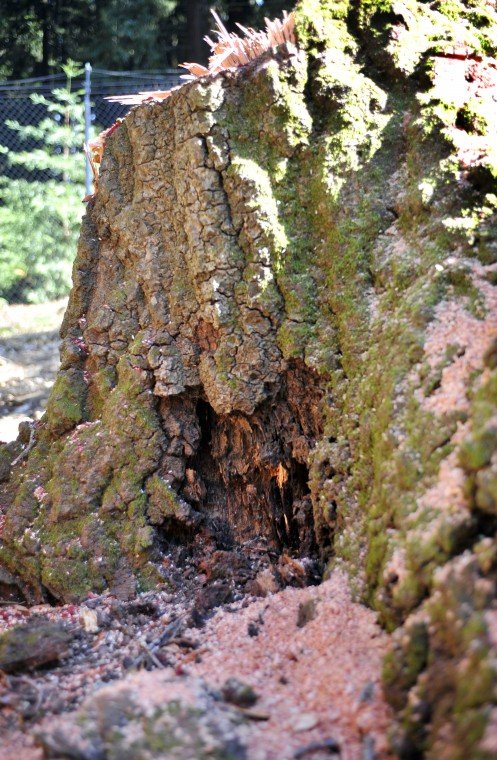Silent as the grave and hauntingly beautiful in the overcast hue of a rainy February afternoon, Mount Madonna County Park looks like a massive crime scene. Ribbons of yellow caution tape are strung everywhere, blocking entrances to various picnic areas and campsites.
Nestled in the Santa Cruz Mountains near the top of Hecker Pass Highway, the forested Santa Clara County park marked by mossy branches and lush vegetation is getting a major prune job. Around 1,000 sick tan oak trees – some nearly a century old and measuring 120 feet tall – will meet their end as power saws send them crashing to the ground now until late May.
Park rangers and county staff assure it’s for the best.
“We’re concerned about it, but by the same token, the safety of the people coming up there is the most important thing,” explained John Heenan, a senior park ranger at Mount Madonna for 10 years. “We’ve had trees that have fallen around campsites, and that’s the issue. A sick tree is a hazard.”
Portions of Mount Madonna – a natural gem and popular recreation area with a 14-mile trail system, 118 campgrounds and a relatively new cluster of Yurts – will be intermittently closed to the public until peak season, which begins Memorial Day and continues through Labor Day.
While a majority of the campgrounds are temporarily off-limits, all hiking paths and equestrian trails will remain open.
The infected trees, some of which were felled in early February, are located within the developed regions of the park. Heenan said this accounts for less than 10 percent of the park’s total 3,688 acres.
Overall, the entire project of cutting down 1,000 at-risk/infected tan oaks, and a few madrones will cost the county an estimated $250,000, according to County Parks Spokeswoman Tamara Clark-Shear. The money comes from a park charter fund; about one percent set aside from the county’s general fund.
“It’s all within the use sites only,” reminded Don Rocha, Natural Resource Program supervisor for the Santa Clara County Parks Department. “We’re not cutting down trees that are out of the use areas,” he said, referring to the fact the county will not be cutting down trees in the heart of the forest.
Recent hazard assessments which are regularly conducted by the Parks Department revealed a higher than average number of tan oak trees to be infected with, or showing early signs of a naturally occurring fungus called Armillaria.
The untreatable disease is a genus of mushroom that attacks the health and vigor of the tree, Rocha explained, eventually causing it to weaken and fall over.
Rocha said the goal is to open up one section of the park, Valley View 1, relatively soon. This will be followed by the youth camps and a deer pen containing the park’s prized herd of white fallow deer (originally a gift from 19th century newspaper baron William Randolph Hearst) in the spring. The entire park will hopefully be open by the start of peak season in late May, Rocha said.
Park staff has been able to work around existing camp reservations, but plans to relocate campers if a particular site hasn’t been deemed safe. New reservations, however, won’t be accepted until work in each respective area has been completed.
While the county annually cuts down between 50 to 80 trees showing signs of root rot, Rocha isn’t exactly sure why the fungus is more aggressive this year.
“We’ve had some really cool summers and really cool winters,” he said. “And being a fungus, (Armillaria) likes those conditions.”
Noticeable symptoms of Armillaria include yellowing foliage, depleted canopy branches, heavy resin flow and a white, flaky mat of fungus growing beneath the bark at the base of the tree and clusters of honey-colored mushrooms sprouting near the tree roots, according to the U.S. Department of Agriculture. The disease spreads when shoestring-like fungi (called rhizomorphs) growing through the soil contact uninfected roots, or when uninfected roots directly contact infected roots.
Park personnel have also detected a second disease, something Rocha described as a form of oak rot canker that attacks trees from the core of the trunk. The canker is wind dispersed, spreading to trees with “open wounds” (exposed areas caused by pruning, a vehicle bumping into a tree, etc.).
Rocha said the county is bringing in a pathologist and forester to further assess the situation, and guide the county in implementing the best management practices for dealing with the infected trees (which does not include Redwoods).
None of the trees targeted for removal contain bird nests, according to Rocha. Felled trees are sent through a wood chipper and the chips will likely be used as natural mulch in open areas to help with weed abatement. Spokeswoman Clark-Shear said the park doesn’t have the resources required to turn the felled trees into firewood for sale.
This isn’t the first time Mount Madonna has cut down a hefty cluster of sick trees.
After several tan oaks collapsed near the campgrounds in 2001, county staff closed portions of the park and cut down about 250 infected trees, Rocha said.
Heeler said there haven’t been any “bad incidents” to prompt another purge; rather, “we’re just taking precautions,” he explained.
Since closing sections of the park in early February, Rocha said six trees have collapsed on their own near several campsites.
Mount Madonna’s four-person maintenance staff and a Watsonville-based contractor, Pacific Firewood & Lumber, began in early February Phase I one of the tree removal. This includes Valley View 1, the Tan Oak Campground, Arrowhead, Buckhorn, Cherokee youth group overnight camp sites and one of the deer pens.
Phase II will include the old deer pen, the archery range, the Huckleberry group overnight campsite and the historical ruins site of a summer home that once belonged to 1800s cattle baron Henry Miller. Phase III includes Valley View 2, 3 and the Manzanita group overnight campsite.
Heenan said Mount Madonna will not lose a significant amount of revenue while the project is being carried out. Portions of the park are regularly closed for maintenance during the winter, he said.
“For the most part, we’re not very busy in the off season, anyways,” Heenan said.
While Rocha noted sending 1,000 trees to an early death isn’t an enjoyable task, he highlighted the county’s contrasting responsibilities of balancing recreation, public safety and protecting natural resources.
“From the (parks department’s) perspective, we have to provide safe access to our parks, but we’re also a preserve and protect agency,” he said. “It’s definitely a hard thing to do.”














